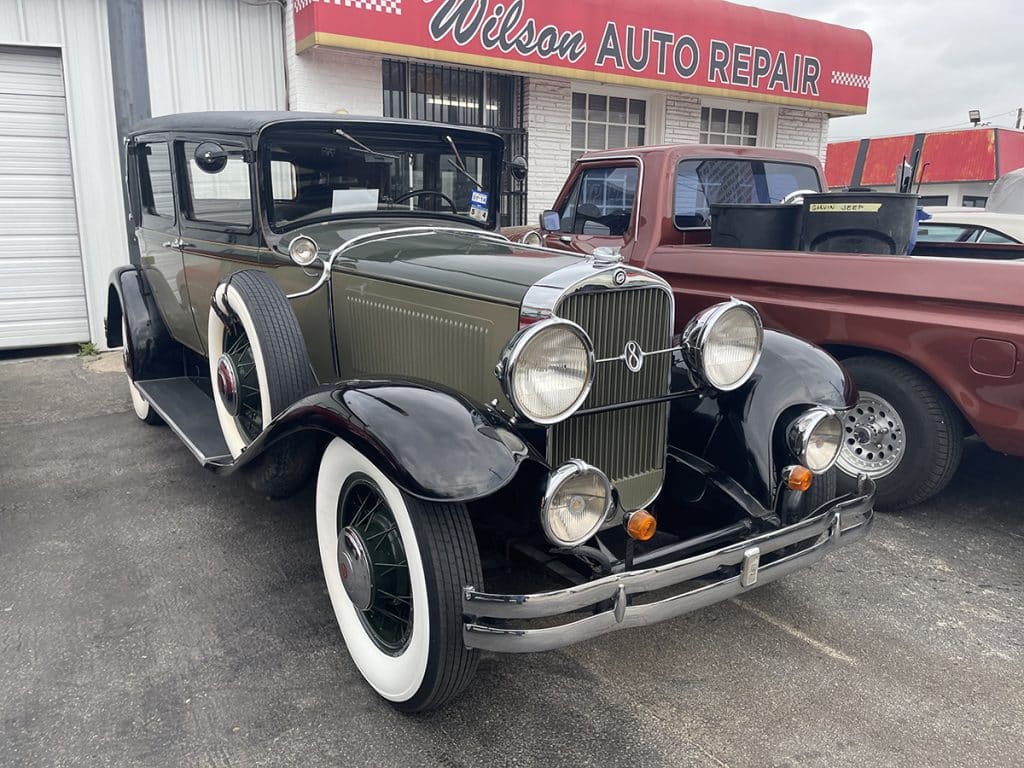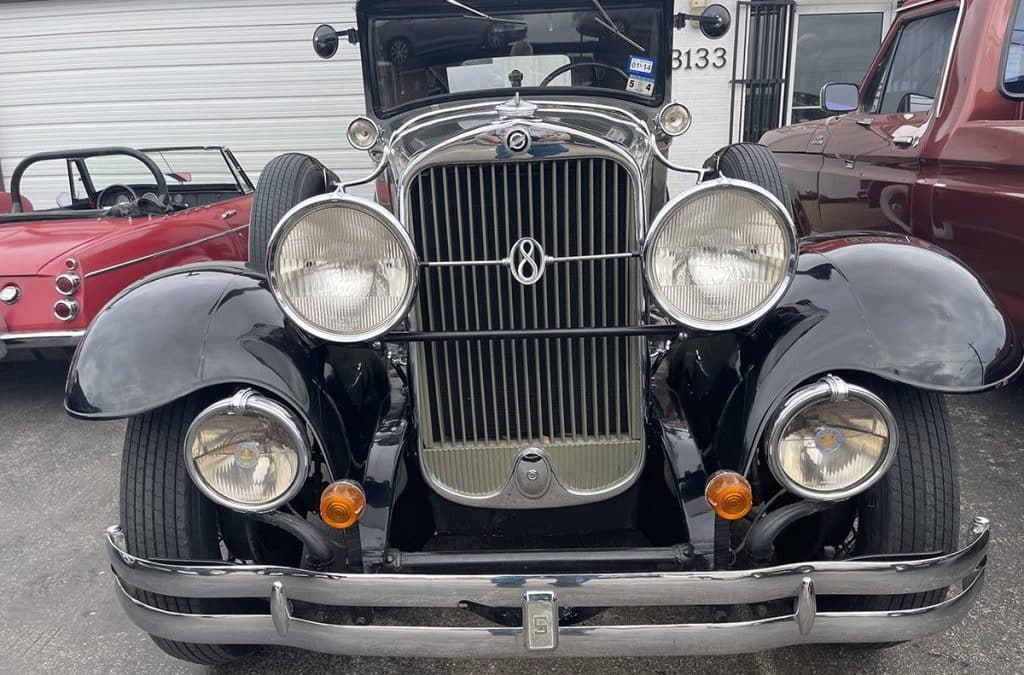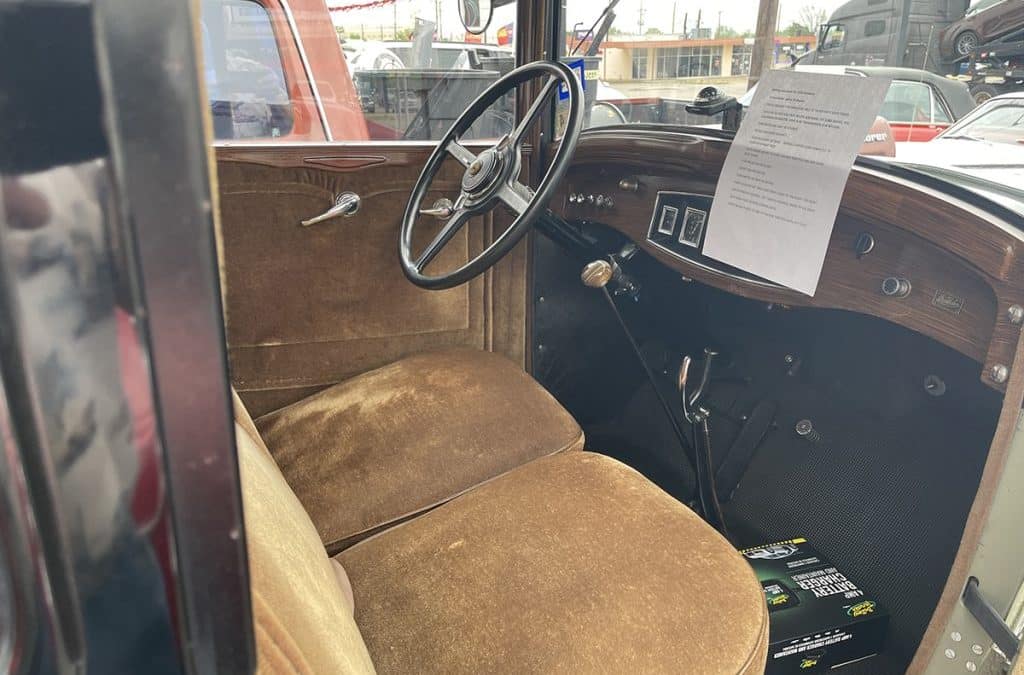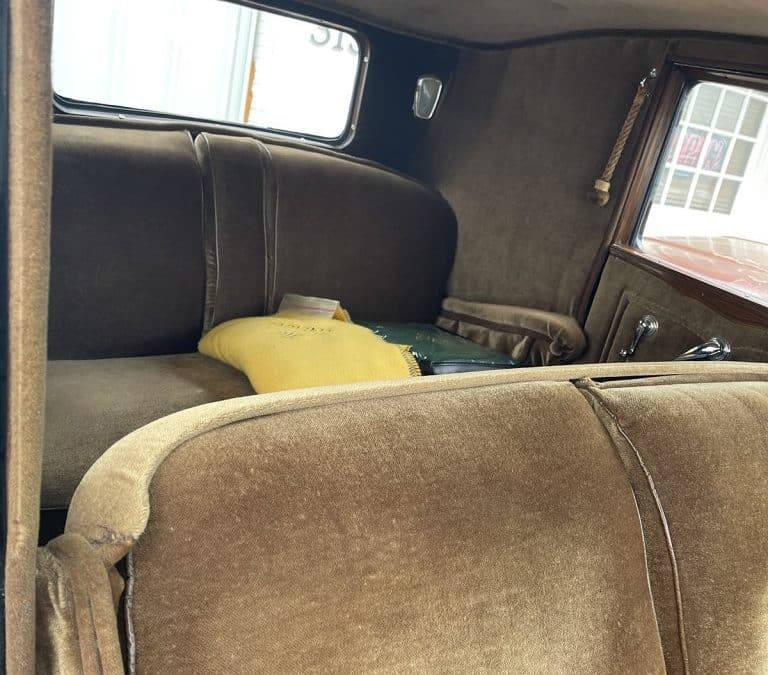We had the honor of working on an extremely rare 1930 Studebaker President. It was in the Great Race of 1996 and the following is a re-creation of an article, from The Antique Studebaker Review, written by the navigator of the race himself, Whitney E. Kerr in the January-February edition.
Please enjoy the re-written article below and feel free to check out the original article in PDF by clicking here.
When my friend Larry Cain of Dallas, Texas, saw the Interstate Batteries Great Race go through Dallas in June 1995, his interest in the sport was renewed. During the ’50s Larry owned an MG and was active in sports car rallies. Larry remembered that my father and I had driven a 1930 Studebaker President 7-passenger Sedan in the 1985 Great Race and asked me if I would navigate while he drove in the 1996 Great Race. After several discussions we asked my father to look for a car we could drive.
My father had sold a 1940 Packard several months before, and his first thought was to look for a 1940 Packard with synchromesh transmission and hydraulic brakes. The Packard 120 and Buick Century of 1940 had good acceleration and good brakes, with synchromesh transmissions. He found several of each make and year that had been restored with good paint and upholstery, but a driving test left questions about mechanical condition. Then upon reading the rules for scoring, we learned we would be handicapped with a newer car, so we started looking for an older car.
By then it was the middle of November, and we remembered Kenneth Johnson of Burlington, Iowa, who owned a 1930 Studebaker President Brougham. Kenneth had the car restored in 1974, and the paint and upholstery were beautiful. We did not drive the car because the battery was down. We decided not to look any further and arranged to get the car over Thanksgiving weekend. Kenneth agreed it would be better to drive the car the 300 miles to Kansas City than to trailer it. During the past 22 years, the car was only driven in parades and to car meets close to Burlington. I did not question the mechanical condition because of the beautiful appearance and Johnson’s opinion that we should drive the car to Kansas City.
Our experience with this car is being told to show how an owner and a purchaser can be surprised about the dependability of a 65 year old car that is beautiful but has not been driven much. I hope this story will be a guide for others so they will not be stranded on the highway with dirt in the gas tank. Most certainly I know Ken Johnson was as surprised as we were that we had gas line troubles.
Friday after Thanksgiving, my father and I drove to Burlington, Iowa, in my father’s Ford pickup to get the car. The gas tank was about half full, and Ken suggested we fill up and not let the gas get low in the tank. My father drove the Studebaker, and I was following in the Ford pickup. The car ran smoothly but seemed to lack power. Several days later we found the choke butterfly on the choke valve did not open fully, causing excessive gasoline use and loss of power. The gas gauge did not work; so, when we left Burlington, we thought we could get to Missouri where gasoline is 15 cents less per gallon than in Iowa. Just north of Keokuk, Iowa, the car ran out of gas. When I asked my father what was wrong, he admitted he was trying to get to Missouri. I reminded him he was driving 60 miles an hour on 55 MPH roads.
I towed him to the nearest gas station where he foolishly opened the gas hose nozzle wide open and stirred up dirt in the bottom of the tank. The car stopped about two miles down the road. It was about noon and, to make a long story short, the rest of the day until dark we went in two mile jumps until we towed the car to Paris, Missouri, where we left it for the night.
Saturday morning, we put the car on a grassy area where we could get under it to clean the electric fuel pump and blow out the gas line with compressed air. We thought we had our problem solved but were only able to go about a mile when we stopped again, because the gas line plugged up again. At this point we decided to tow the car to Arrow Rock, Missouri, where I have a farm. We reached there at dark and put the car in the barn.
Monday, we fixed up a can of gasoline with copper tubing to the carburetor to drive the car onto a trailer, and took it to Overland Park, Kansas, to my father’s house. The lesson from this experience is to not let the gas get low in a tank that might have sediment. It can happen to a very good old car.
Our first order of restoration was to remove the gas tank, carburetor, fuel pumps, filter and gas lines. The gas tank was put in a caustic tank for cleaning, and we discovered the top of the tank had many pin holes. The top of the tank was cut out and the inside of the tank glass bead blasted. There was at least a quart of rust in the tank when we opened it up. After a new top was installed, it was coated inside with alcohol resistant sealer. A new filter and electric fuel pump were installed close to the tank with new gas line to the carburetor. The carburetor was cleaned and overhauled with new float valve and seat. A new mechanical fuel pump was installed in series with the electric fuel pump so the electric pump would only be used in case of vapor lock. The King Seeley gas gauge was repaired with new tubing and fluid and is now quite reliable.
With a clean source of gasoline, we took the car for a test drive. The car ran fairly well but didn’t have the power I had expected, and the engine seemed noisy. After further driving tests, and compression and vacuum tests, my father decided to do a complete mechanical inspection and overhaul. Most cylinders had 90 pounds compression, but one had 80 pounds and two had only 75 pounds.
We knew from our experience in the 1985 Race that a car must be in top mechanical condition to be competitive and dependable. Fast acceleration through the gears and good brakes are a must. The engine and transmission were removed and taken to the same machine shop that had rebuilt two other President engines for us. About a week later, the machine shop called and wanted us to see what they would recommend for rebuilding. The cylinders were less than one thousandth out of round or taper and only required honing. The pistons were all okay and only needed new rings. All the valve guides needed to be replaced along with all new valves and new valve springs. The water manifold had been removed and all scale had been removed from the block with chemicals. Hardened valve seats were to be in-stalled in the exhaust ports. The crankshaft was to be reground and the dynamic balancer was to be rebuilt with new plates. The connecting rods were to be rebabbited with centrifugal casting, realigned, and all weighed for accurate balance. Pistons were to be all corrected for the same weight. New bearings were cast for main bearings and camshaft bearings and each was line bored. The camshaft was reground to provide higher valve lift. The top of the block was ground along with the cylinder head to be flat within one thousandth of an inch. The oil pump was machined and fitted with a bronze pump body. The flywheel was resurfaced for the clutch plate. The clutch was rebuilt with new plates and a new clutch throw out bearing. The transmission was rebuilt as best as we could with new bronze bushings and new ball bearings. The transmission is not as quiet as we would like because we were unable to find a better cluster gear.
While all this was being done at the engine rebuilding shop, my father was cleaning and repacking universal joints and making new seals for the ball covers. While adjusting the brakes, he discovered that the brakes had good lining but only one shoe, of the three, in each wheel was touching the drum. The front brake drums were slightly out of round, but we thought they would be acceptable. Both front and rear wheel bearings were cleaned and repacked. All grease seals in the wheels were okay.
My father overhauled the distributor with new cap, points and condensers and two new ignition coils with new spark plugs and plug wires. The starter and generator were taken to a generator repair shop and rebuilt. The generator was changed from a three brush using the cutout to a two brush for use with a voltage regulator. The fan shaft was reworked, and new fan bearings installed with a new six bladed fan. The radiator was taken to a very good radiator shop that we have patronized for years to be cleaned and rodded out. The fill connection in the top tank of the radiator was modified for the cooling system to run at four pounds pressure with a radiator overflow jar.
A friend of my father, whom we consider to be a good machinist, inspected the water pump and advised he would not touch it since the shaft was well polished and the bushing and packing seemed to be in good order. This decision turned out to be a mistake, since we had water pump problems enroute to Tacoma, Washington. The exhaust manifold that came on the engine had a bad crack, and our expert advisors thought it should be replaced. We bought an exhaust manifold that was supposed to be without cracks, but after glass blasting a small crack was found, so it was repaired with brazing. So far it has held.
When we were in the Great Race in 1985, the pulley on the generator broke, so we replaced the sheet metal stamped pulley with a solid steel pulley on the generator.
With the car on jacks and the wheels off, and with the engine and transmission out, my father was able to sit on a small stool under the dash with the floorboards out, and completely rewire the car. He used high temperature stranded oil and gas resistant color coded wire. A fuse block was installed with six circuits, replacing the single circuit breaker.
To make the car safe for highway driving, turn signal lights were installed front and rear. Electric windshield wipers were installed to replace the vacuum type. To comply with the Great Race Rules, the clock and speedometer were removed from the dash. A more accurate speedometer is desirable, so we purchased a Jones Speedometer that is graduated in one mile increments and only goes to 60 MPH. This speedometer operates like a ball type governor with balls which are thrown out by centrifugal force. It has a heavy cable to eliminate any waving of the speedometer hand. The Jones Speedometer was mounted on the steering column for easy reading by the driver. Seat belts were also installed to meet race requirements.
After the engine was installed in the car a new type of screw on oil filter was installed to replace the original oil filter. On our way to Tacoma oil leaks made it necessary to eliminate the oil flow through the filter since the seal could not hold against the 80 pounds of oil pressure.
Four months after we removed the engine and transmission, we had completed the work on the wheels, brakes, rewiring and engine overhaul. It took about two weeks to install accessories on the engine and install the radiator. When we had it all assembled, we started the engine and ran it in the garage until the radiator started steaming with several leaks. To our surprise our $90 radiator cleaning was a waste of money. Rather than trying to fix the 65 year old radiator, we had a new radiator core made and used the upper and lower tanks from the old one. With the new radiator installed, we were ready to take the car for a road test. The first test was only about five miles in city traffic, and everything seemed to work well except the ammeter did not show any positive charge, only negative. When the generator was returned to the shop that rebuilt it, they found the wire from the field coil had broken when the terminal was tightened. They fixed it at no charge, but two days were lost.
The next road test was for about 20 miles, and everything seemed to be normal until the car cooled down and we found the radiator overflow jar was empty. A second road test, after refilling the radiator jar and climbing some hills, told us we had a swelling of the radiator coolant. Further tests, without the water pump running, showed we had gasses leaking into the coolant which meant we had a bad head gasket. The gasket we used in assembling the engine was NOS, but we knew it had a small dent in the copper ring around the firing chamber. Our next try was with a used head gasket, which appeared in fairly good condition without dents, but it too failed after driving about fifty miles. In each case we would disconnect the operation of the water pump by removing the fan belt and run the engine in the garage by accelerating the engine and watching for a rise and bubbles in the radiator fill neck. Our third head gasket was NOS. (So far, the car has been driven approximately 7,500 miles and is holding.) By now it was June 10th and time for us to leave for Tacoma, Washington.
The distance to Tacoma from Kansas City is over 1,800 miles. Larry Cain, my father, and I left Kansas City at 3:30 PM, Monday, the 10th of June. It was sobering to realize we had to arrive in Tacoma early Friday morning the 14th of June, to have the car inspected before noon that day. We hoped to drive no more than ten hours a day. At 45 MPH average speed, we could cover 450 miles per day. That meant averaging 45 MPH including fuel and pit stops and hoping there would be no need for repairs.
The three of us took turns driving, and we tried to drive between fifty-five and sixty miles per hour. We were advised not to exceed 61 or 62 MPH because of the risk of ruining the calibration of the Jones Speedometer which had a maximum speed on the dial of 60 MPH. The old Studebaker President is capable of considerably higher speed than the low sixties.
Our first problem was overheating caused by coolant leaking out of the water pump shaft. The packing around the water pump shaft would not contain the coolant. At every stop, we would add water to the expansion tank and tighten the packing nut on the water pump shaft. At one stop, we had to scoop rainwater from a ditch, since there were no service stations or inhabitants anywhere nearby.
The next problem was oil leaking out of the top of the oil filter. The oil pressure on the rebuilt engine was very high, over 80 lbs. No matter how tight we turned the filter cartridge, or how often we changed the gasket, we could not contain the oil pressure. It sprayed oil mist all over the interior of the engine compartment, and oil ran down the louvers on the sides of the hood. We had the inconvenience of adding a quart of oil every fifty miles, not to mention the mess that it had made.
We stopped in Iowa and tried to reduce the oil pressure by adjusting the oil pressure regulator on the right front side of the block. Apparently, the wedge regulator was stuck in the block, and we couldn’t get it loose. All the time we spent stopping to cure water and oil losses was cutting into our average speed and reducing the distance covered. The first day out we only covered 300 miles. That meant we had to cover the remaining 1,500 miles in three days, averaging at least 500 miles per day in a 66 year old car, with drivers ages ranging from 60 to 87 years of age.
After struggling with the oil filter leak, my 87 year old father, who was the only competent mechanic on board, decided we had to stop and bypass the oil filter. We pulled into a roadside truck stop somewhere east of Rapid City, South Dakota, and re-routed the copper oil lines, fabricating and bending new copper lines. That effort took my father nearly an hour and a half. Part of the time was lost because the engine and oil were so hot, we couldn’t touch it.
With the engine cooled down, the radiator full and the oil leak stopped (we thought), we started out again with renewed optimism. A short time later while Larry was driving about 60 MPH, he shouted, “I think we have a flat tire.” We had just experienced our third chronic problem. He pulled onto the shoulder, and we climbed out to see the right rear tire nearly flat. That was the first of three flat tires on the way to Tacoma. The reader will please note rule #1 for the Great Race.
Rule #1: Don’t believe your tire company when they tell you. “Those old tubes look great.”
Replace them! While we had excellent tread on our new tires, our problems resulted from valve stem leaks. As novices, we thought we didn’t need to replace those tubes. Fortunately, we had brought extra new tubes with us.
The second day out we pulled into Rapid City, South Dakota, to spend the night. When Larry and I got out of the car we noticed a long stream of foaming radiator coolant trailing behind us into the hotel parking lot. I told Larry not to say anything about it to my father. We were all dead tired, and I thought to myself, if that NOS head gasket has failed again, I’m not going to tell my father until morning. At least we can get a good night’s rest before facing the disaster.
Nervously, the next morning we added coolant and were delighted to find the head gasket had not failed. We added oil and had the flat tire repaired at a truck stop. Changing tires on a 1930 Studebaker President is no problem but demounting a tire and tube from a 19″ snap ring wire wheel is beyond the capability of most service stations.
Lesson #2 – You need to find a truck tire specialist.
After installing the new tube and with the renewed confidence of two spares, we resumed our journey.
We drove long and hard at 60 MPH, had two more flat tires (because of tubes), continual coolant loss through the water pump and soon discovered a new and different chronic problem. The front oil seal on the crankshaft was leaking oil, and in large quantities. When the engine was rebuilt in Kansas City, the crankshaft seal had been replaced, but it was done with an adapted new felt seal. Being behind schedule, we decided to hurry on and just keep adding oil.
In the meantime, I called long distance to the Universal Tire Company in Lancaster, Pennsylvania, and ordered two new 6.50 x 19 tires, tubes, and flaps and had them air freighted to the hotel in Tacoma to await our arrival.
About 9:30 AM Friday morning, the three of us drove the old Studebaker into the Great Race Vehicle Inspection. We were on time! We had traveled 1,800 miles in less than four days driving. The car seemed to be loosening up and was running well except for the various leaks.
We quickly passed inspection, loaded in the new tires and tubes, and headed off for a Goodyear Truck Tire store to install new tubes in all tires and spares. On the way, my father seemed worried and told Larry and me that he really thought we should tear down the front of the engine and replace the front end crankshaft oil seal. That afternoon we stopped at an automobile parts store, and at that point our luck began to change for the better.
A very curious and friendly retired schoolteacher named John Hayward came up to admire the old Studebaker. When John heard about our problem, he invited us to go to his house the next day (Saturday afternoon), and offered his garage, shop tools, and assistance. On Saturday morning at 9:00 A.M., the practice rally was scheduled. Larry, my father, and I went on the course. At the end of the practice rally we received permission to leave the luncheon gathering early and drove directly to John Hayward’s house. Within an hour, with John’s help we had the hood off, headlights off, radiator off and front of the engine opened up. John worked with us to stop the oil hemorrhage by replacing the crankshaft oil seal. About four hours later the car was back together. John wouldn’t take a dime for his help and the use of his garage and tools!
Early the next morning (Sunday, the start of the race), my father had planned to fly back to Kansas City. Since the start of the race was Father’s Day, I thought the Saturday evening before would be an appropriate time to celebrate Father’s Day. Larry, my father, and I went to a very nice restaurant in Tacoma and had a very good dinner and a fun time. I kept thinking how blessed I was to have an active 87 year old, master mechanic, and pal with whom to share this experience.
By the time we got back to the hotel after dinner, it was 10:00 P.M., on the eve of the race. We were still tired from the cumulative effect of the long drive out, the excitement of the practice rally, and the urgency of our repair operation at John’s house. To our great disappointment, when we looked under the car, the oil leak had resumed. We debated what to do, fearing that the oil leak might well cause us to drop out during the upcoming 4,300 mile course. We decided to call John Hayward. He said, “I’ll be right down.” Within minutes, we were in the basement of the hotel, the Studebaker was up on blocks, and it was midnight. John assured us that he had an oil leak sealer that was almost magical. He cleaned off the oil leak around the front of the engine, applied his THOROSEAL and told us that it should work. I must admit now that I was very skeptical at the time. The oil leak was reduced to the point of not being a problem, and the sealer has held up ever since. John Hayward was a life saver. Thank you John!
Early the next day we said our good-byes to my father, who headed to the airport, and Larry and I wondered what was in store for us. We drove over to the starting point and nervously awaited the start. Larry and I felt like we had already been on the race with all our adventures driving out to Tacoma!
The Great Race is a Great Experience! It is a demonstration of faith. You must have faith in your machine, faith in your driver or navigator, and faith in yourself. Through the experience you develop a stronger faith in God. As I reflect on my most vivid and lasting impressions, I recall the many acts of kindness that benefited Larry, me and my father.
I’ll never forget the kind, friendly and excited faces of thousands of our fellow American citizens who welcomed us into their communities. Experiencing their warmth, hospitality, and enthusiasm was a moving experience to each of us.
Prior to the start of the race, all of us were told by Tom McRae, President of the Great Race, that we should be friendly and available to those people who wanted autographs. I thought he was kidding. We must have signed hundreds of autographs! After going on this trip, one can’t help but feel the warmth and love of the American people.
Our second big impression was experiencing the enthusiasm and support of the Antique Studebaker Club and the Studebaker Drivers Club and its members all across America. Everywhere we went, they were there to cheer us on. Time doesn’t permit a detailed account of each of the thirteen days from the 16th through the 29th of June, but I must mention the following experiences.
The old car exhibition in Billings, Montana, was the most outstanding in my memory. The Yellowstone Chapter of SDC was out in big numbers with their beautiful Studebakers. When we arrived, they asked what we needed. We mentioned problems with the second hand on our battery powered clock. Within minutes Jackie and Laurie Streets were back with a new clock.
Mark and Sherry Ferguson took us for a personally escorted tour of the automobile exhibition with special notice of course of the Ferguson’s ’51 Studebaker Champion. When I mentioned our chronic water pump leak to Mark, he said he would try to find some pump packing for us. We didn’t see him after that, but imagine my surprise the next day at the morning pit stop many miles away from Billings, when I saw Mark Ferguson. He had driven all the way to catch up with us and to deliver some pump packing to me. Now that’s what I call “Studebakerly yours!!” Thank you again, Mark!
Ingvar Vik, also of the Yellowstone Chapter, had assisted my father on many matters related to the restoration of our car. He had sold the replacement exhaust manifold to Darrell Dye, who in turn had sold it to us. Now for lesson #3. When Ingvar asked how we were doing and I told him about the water pump packing, he told us to get some tallow impregnated industrial hemp packing. I called my father that evening, and he obtained some German made industrial pump packing. The Studebaker water pump has not leaked a drop since it was repacked in Kansas City June 22nd.
As we drove across the country, we saw Studebaker fans and ASC/SDC members at almost every stop. When we arrived in Peoria, Illinois, Larry Swanson and Dick Quinn were there, and we enjoyed visiting about the race and about our Studebakers. Thank you Larry and Dick! We also met for the first time Lloyd Lopez and his brother John. The Lopez brothers followed the race in their car and were our cheerleaders across the United States from Peoria to Toronto. John and Lloyd joined us at the banquet in Toronto and sat at our table. Their support and encouragement will long be remembered. Thank you Lloyd and John!
By the time we left Kansas City, we had readjusted the brakes on the car, had repacked the water pump shaft, and had solved the oil leak problems. The old car was running well. The mechanical performance of the machine was good until we reached Adrian, Michigan. We stopped for a midafternoon pit stop and a man came up to me and said, “Mister, something is hanging down under your car.” When I investigated, I discovered the left front wheel brake rod was disconnected about four feet behind the front axle. It was dragging on the ground. A volunteer raced to the corner hardware store and brought back a case hardened bolt. With great difficulty we managed to reconnect the bolt and secure it with bolts, cotter pins, etc. Having lost valuable time and being on the clock, we raced off to start the next leg of the race. At the first corner, Larry exclaimed, “Oh my God, we don’t have any brakes!”
For the next 65 miles, until we reached Southfield, Michigan, we drove with the emergency brake only. Fortunately, it held up. We managed remarkably well considering the terrain and the many times we needed to depend on it to stop the 5,180 lb. Studebaker President.
When we got to Southfield, Michigan, that evening “Grandpa” Stanfield adjusted the mechanical brakes on the car, and they have worked very well ever since. Thank you, “Grandpa” Stanfield!
When we crossed the finish line in Toronto, Larry and I both had a real feeling of accomplishment. Somehow with the Grace of God, the help of many people, the restoration work, and the tutoring of my father on the 1,800 mile trip from Kansas City to Tacoma, Larry and I had managed to drive the 66 year old Studebaker President over 6,100 miles. We finished 18th in a field of 55. Not in the money for prizes, but definitely a respectable score. Would we do it again? Sure! Larry has already signed up for 1997.





